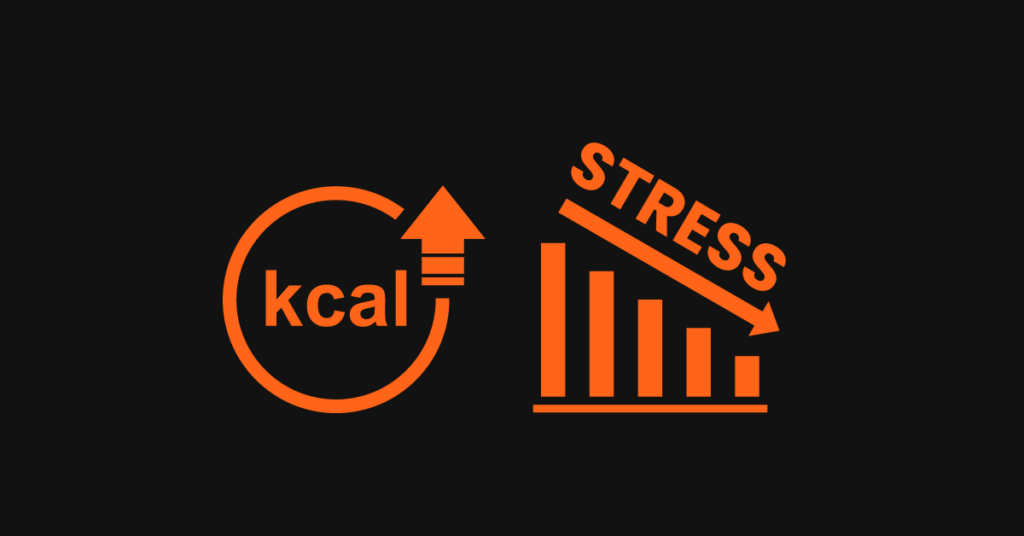5:2 calorie cycling for fat loss
key takeaways
What is calorie cycling?
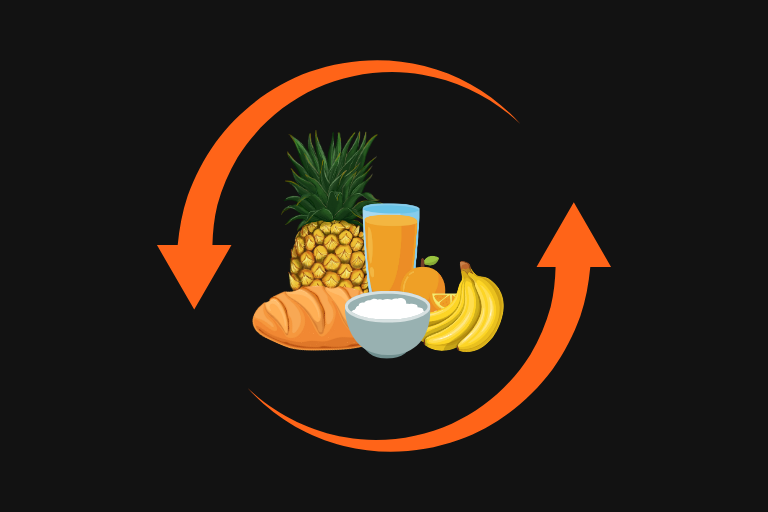
As the name suggests, calorie cycling involves planned increases or decreases in daily calorie intake throughout the week. There are many different calorie cycling protocols, some use high and low days, while others use high, medium, and low days. Calorie cycling may also be called the zig zag diet, the calorie shifting diet, or the calorie cycling diet. Calories are usually increased by consuming more carbohydrates on high days, although this is not always the case.
calorie cycling versus carb cycling
Calorie cycling is sometimes confused with carbohydrate cycling. Although they are similar, they are not the same. With carb cycling, varying amounts of carbohydrates are consumed depending on the day of the week, while calories stay relatively the same. High-carb days will contain lower amounts of dietary fat, while low-carb days will contain higher amounts of dietary fat, resulting in the same amount of calories consumed. When people say they are carb cycling they are usually keeping dietary fat the same, therefore they are calorie cycling.
calorie cycling for fat loss
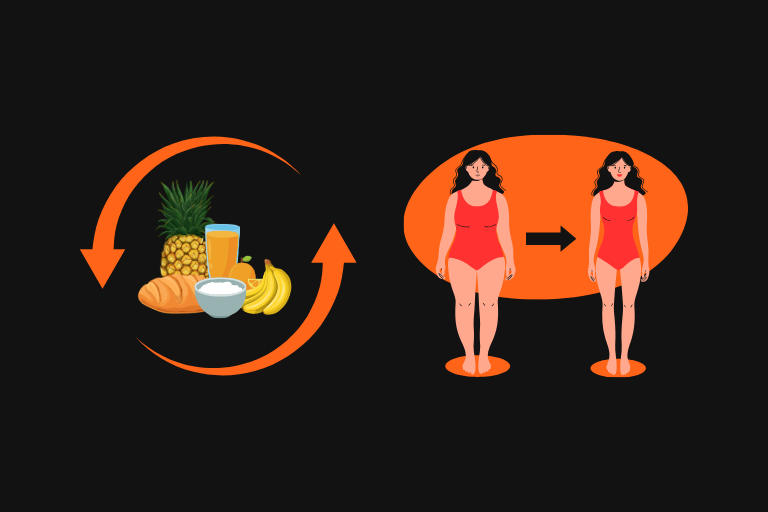
Calorie cycling can be used at any time, although we believe it is most useful in a fat-loss phase for most people. With that said it can also be a useful strategy in a gaining phase. This is best suited to more advanced individuals who have already built a large amount of muscle and are looking to gain some muscle (although at a slower rate) and minimize any potential fat gain when in a calorie surplus.
Calorie Cycling and metabolic adaption
When we restrict calories to create a negative energy balance to lose body fat the body will make some adaptations to protect itself from a reduced energy intake. Calorie restriction will result in hormonal adaptations such as decreased testosterone in men, decreased thyroid hormone, and decreased leptin. Other hormones will increase such as the stress hormone cortisol and ghrelin. This will result in a slowing of the metabolic rate, reduced energy expenditure, and increased hunger levels, all of which make fat loss and adherence to a calorie deficit more difficult over time. The degree of these adaptations will likely depend on the size of the calorie deficit and the amount of time spent in it.
The idea behind calorie cycling is that we can negate some of these negative adaptations from a low calorie diet by raising our calories on certain days throughout the week. These high days eating at around maintenance calories or even slightly above maintenance, give our body a slight rest bite from a calorie deficit. While this theory sounds plausible, eating at maintenance calories for a few days throughout the week is unlikely to negate metabolic adaptations by the body, due to a prolonged period in a calorie deficit.
Some research even suggests that longer periods of one week of eating at maintenance calories are not enough to prevent metabolic adaptations to a calorie deficit. The study found that taking diet breaks had no significant effect on hormones that are associated with hunger, muscle mass, and metabolic rate, such as ghrelin, testosterone, leptin, or thyroid hormone. However, people who took diet breaks reported feeling less hungry and irritable and more full and satisfied despite eating in a calorie deficit. People also reported feeling more alert compared to those who dieted continuously.
We have also found this to be the case for some individuals who take shorter periods of eating at maintenance calories such as for 2 back to back days per week.
the 5:2 calorie cycling Protocol for fat loss
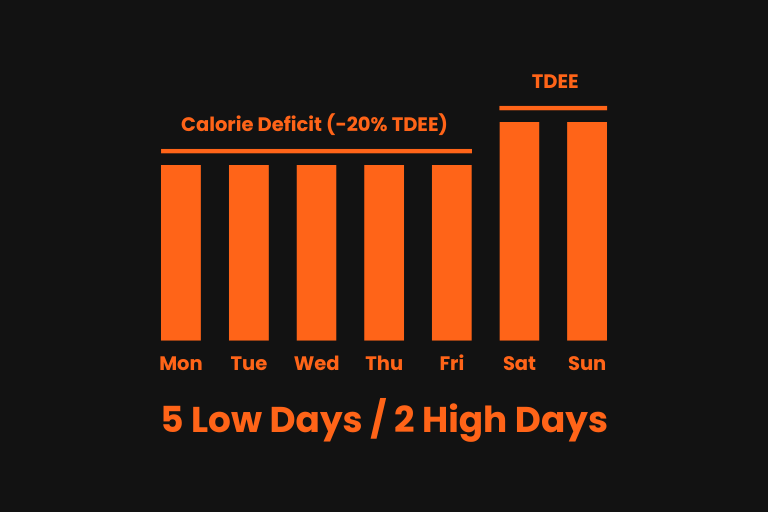
The 5:2 calorie cycling protocol is our preferred method of calorie cycling. This protocol uses 5 low-calorie days followed by 2 higher-calorie days where calories are raised to around maintenance calories, mostly from carbohydrates. We may also increase dietary fat slightly to allow for a little extra freedom in our food choices if dietary fat is relatively low. We prefer 2 back to back days at around maintenance calories compared to 1 or 2 separate high days throughout the week as is sometimes used. Depending on the situation, we may also raise calories a little higher, aiming for a small calorie surplus of around 10%.
benefits of the 5:2 calorie cycling method
As mentioned previously, it is unlikely that raising calories a few days throughout the week will negate any metabolic adaptations to any large degree, however, this does not mean there are no other benefits to calorie cycling, specifically the 5:2 calorie cycling protocol. Here are some of the main benefits of this calorie cycling protocol:
Performance
Depending on how long someone has been dieting, the amount of calories they are on, and therefore carbohydrates they are consuming, muscle glycogen (stored carbohydrates in the muscles) will become somewhat depleted, which can affect performance in high-intensity activities such as strength training. This may be more or less of an issue, depending on the amount of volume they are performing, and the repetition ranges they are using. If they are performing other high-intensity activities, such as sprinting, HIIT, or playing any sports this may also be more of an issue.
Raising calories to around maintenance, predominately from carbohydrates, for a few days per week can help replenish glycogen stores a little. This opportunity to raise carbohydrates and restore muscle glycogen levels, especially when overall calories are low, can be great for performance. Since training is the main stimulus for maintaining muscle mass during a fat-loss phase this can be extremely beneficial throughout a fat-loss phase, especially for more advanced goals such as sub 12% body fat, which will require more time spent in a calorie deficit.
Back To Back High Days
One of the reasons we believe back-to-back high days are more useful than 1 or 2 separate high days throughout the week is that we can schedule our hardest training session, or a priority muscle group around these days. A great way to do this is to place the first high day the day before a hard training session such as legs. This allows for some glycogen replenishment resulting in improved performance and energy the following day when you will perform the session.
The second high day will then fall on the day you are performing the session, allowing more carbohydrates to be consumed on the day, which should also be beneficial for performance and energy levels and may also improve recovery. We often see people place a high day on a certain training day. Although this can work well, we believe it is probably more beneficial to increase carbohydrates the day before a hard training session as well as on the day itself. As with most things in fitness, you may want to experiment to see what works best for you.
Phycological
Similar to diet breaks we believe one of the main benefits of using the 5:2 calorie cycling protocol is psychological. This will likely be more beneficial the longer you have been dieting and the leaner you are, since at this stage hunger levels will be higher, as well as stress levels and fatigue.
We find that breaking a fat loss phase down into blocks of 5 days in a calorie deficit followed by 2 higher days eating at maintenance calories can be useful. The mental reframing of having to eat fewer calories for 5 days while being able to look forward to a few high-calorie days can be helpful. After the 2 high days, an individual will be feeling a little better and can focus on another 5 low days.
Dietary adherence
For some individuals, the psychological benefits of the 5:2 calorie cycling protocol as mentioned previously can improve adherence to a calorie deficit and therefore improve their fat loss results. One of the reasons many people fail to achieve their fat loss goals is that they are unable to maintain a calorie deficit for long enough to see real noticeable fat loss results. Adherence and sustainability are key, especially if an individual has more body fat to lose and is looking to achieve decent levels of leanness such as reaching 15% body fat and below.
Lifestyle
The 5:2 calorie cycling protocol can be useful for aligning an individual’s lifestyle with their current health and fitness goals such as fat loss. Placing higher calorie days on days when they would like to be able to eat a little more and have greater dietary freedom, such as at the weekends, can be a useful strategy. These days should not be thought of as ‘cheat days’ and some accountability and tracking should still be maintained.
Overeating for a few days at the weekend can easily turn your average weekly calories from a deficit to maintenance or worse, resulting in no fat loss. However, when set up correctly, eating at around maintenance calories at the weekend can allow an individual some more freedom for social events while still achieving their fat loss goals.
Aesthetics
From a purely aesthetics point of view, consuming more carbohydrates on high days will also fill out your muscles a little due to the increased muscle glycogen making you look a little fuller and less flat, which is one of the downsides of being in a calorie deficit, consuming fewer carbohydrates, and eating less food overall for a prolonged period.
calorie cycling versus a straight deficit
Physiologically, calorie cycling is likely no better or worse for fat loss than a traditional dieting approach, where a straight calorie deficit is maintained for a prolonged period. The main benefits of calorie cycling will come down to adherence plus some physiological benefits, such as replenishing glycogen levels, although this will not affect fat loss.
Average Weekly Calories
One thing to be aware of when comparing calorie cycling to a straight calorie deficit is average weekly calories. Since we spend fewer days in a calorie deficit, our average weekly calories will be a little higher which means the rate of fat loss will be somewhat slower than if we were in a calorie deficit for the whole week. For example, if you were to set up a typical fat loss phase using a straight calorie deficit, estimating you would reach your goal weight in 3 months, it would take you nearer 4 months to achieve the same amount of fat loss when using a 5:2 calorie cycling protocol.
One possible solution to this is to reduce calories further on your low days, however, this can come with its own issues such as increased hunger levels and reduced training performance and recovery. For most individuals, we prefer to simply extend the fat loss phase a little. If we are working towards a tight deadline and have a specific date to achieve a fat loss goal, it is probably best to use a straight calorie deficit to speed up rates of weight loss.
setting up your 5:2 calorie cycling plan
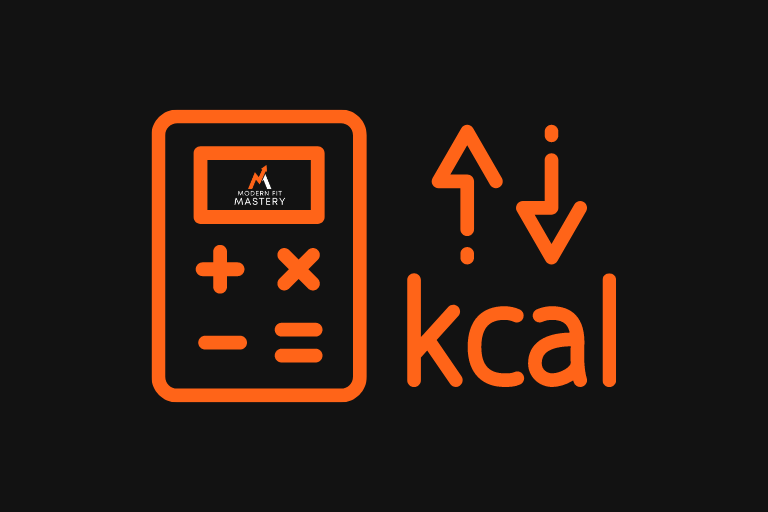
Calories And Macros
The first step to setting up your 5:2 calorie cycling plan is to estimate your total daily energy expenditure (TDEE). This is the estimated number of calories your body burns each day including your resting metabolic rate and daily activity including exercise. TDEE calculators are simply estimations and may or may not be accurate for you, however, they give you a starting point from where you can adjust. If you know the approximate number of calories you can maintain your weight on with your current activity levels, use this instead, as this will be more accurate. You can then estimate the number of calories for a moderate calorie deficit, by subtracting 20% from this number.
For simplicity use your calorie deficit number (-20% of TDEE) for your low days and your TDEE number also known as maintenance calories for your 2 high days. This will result in an average weekly calorie deficit of slightly less than 20%, however, it will still create enough of a calorie deficit for an effective rate of fat loss. If you wanted to maintain a 20% calorie deficit average for the week, you would need to work out your calorie deficit numbers for the whole week (-20% of TDEE x 7) and then subtract your 2 high-day calorie (TDEE) numbers. You would then divide the remaining number by 5 to establish the number of calories for your 5 low days.
Now you have your calorie numbers for your 2 high days and 5 low days you can work out your daily macronutrient targets (protein, carbohydrates, and fats). Protein and fat should remain relatively the same on high and low days. We recommend keeping fat low to moderate. Carbohydrates are increased on your 2 high days to bring calories up to maintenance (TDEE). Here is a good starting point for your initial macronutrient targets. If you would like help working out your initial macronutrient targets you can download our free fat loss guide. You may also want to check out our article on tracking your macros using MyFitnessPal and other apps.
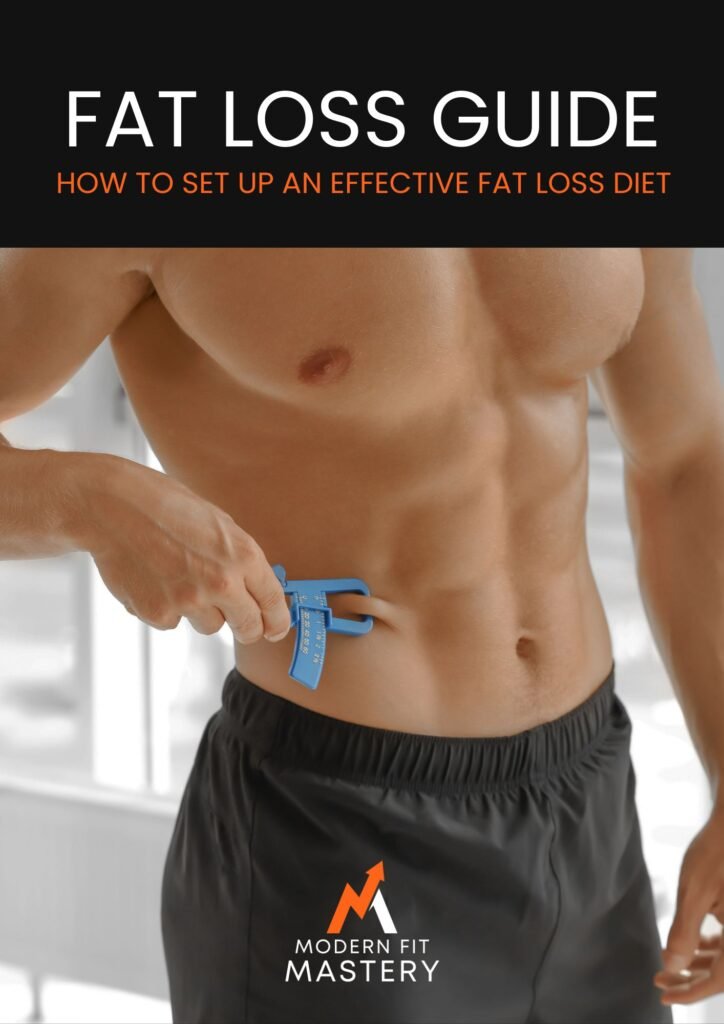
Choosing your high-calorie days
The next thing to think about is where to place your 2 high days in the week. This will come down to personal preference and can be either performance or lifestyle-based, as mentioned previously. In general, we recommend placing your high days around lower body days or around muscle groups you are prioritizing, such as week points, especially if you a performing a little more volume on these muscle groups. Placing a high day the day before and on the training, day works great, although you could also experiment with placing both high days on the preceding 2 days so that muscle glycogen is highest for the session you are prioritizing.
You could also place one high day on a day you are not training. This sounds counter-intuitive, however, we could argue that having more carbohydrates and calories on a rest day, especially if you only have one per week, would be beneficial for recovery. If you have days for smaller muscle groups such as shoulders or have a dedicated arm day, we would probably not place high days around these sessions and would use them for larger muscle groups instead.
example weekly calories and Macros
Here is an example of 5:2 calorie cycling plan for an individual whose approximate maintenance calories are 2500 calories per day. Low-calorie days are set at -20% of TDEE, and high-calorie days are set at maintenance calories or TDEE. Carbohydrates are rounded up or down to the nearest 25g so that adjustments can be made 100 calories at a time (25 grams of carbohydrates), as taught in our fat loss guide. Therefore, carbohydrates are set at 225 grams on low days and 350 grams on high days. This means our average weekly deficit is a little lower than -20% of TDEE.
| Pro | Carb | Fat | Kcal | |
|---|---|---|---|---|
| Low Day | 150g | 225g | 55g | 1995 |
| Low Day | 150g | 225g | 55g | 1995 |
| Low Day | 150g | 225g | 55g | 1995 |
| Low Day | 150g | 225g | 55g | 1995 |
| Low Day | 150g | 225g | 55g | 1995 |
| High Day | 150g | 350g | 55g | 2495 |
| High Day | 150g | 350g | 55g | 2495 |
If we wanted to keep the average weekly calorie deficit at -20% of maintenance calories, the setup would look something like the following:
| Pro | Carb | Fat | Kcal | |
|---|---|---|---|---|
| Low Day | 150g | 175g | 55g | 1795 |
| Low Day | 150g | 175g | 55g | 1795 |
| Low Day | 150g | 175g | 55g | 1795 |
| Low Day | 150g | 175g | 55g | 1795 |
| Low Day | 150g | 175g | 55g | 1795 |
| High Day | 150g | 350g | 55g | 2495 |
| High Day | 150g | 350g | 55g | 2495 |
As you can see, low-day calories become a little low in the second example, and this is why we prefer the first option for most individuals and most situations, using slightly higher average weekly calories even though the rate of fat loss is reduced somewhat. Leaner Individuals at around 15% body fat and below will likely see the most benefits from using the 5:2 calorie cycling protocol, and for these individuals losing body fat at a slower rate is a good idea anyway.
should you use calorie cycling?
Calorie cycling may be more or less beneficial depending on the individual and their current situation. Deciding whether to use calorie cycling now or in the future may come down to your body fat percentage and how far into a fat-loss phase you are.
Leaner Individuals
Calorie cycling is probably more useful for leaner individuals who are further into a fat-loss phase and are around 15% body fat or lower, intending to achieve more advanced levels of leanness such as 10-12% body fat or below. This may have less to do with negating any metabolic adaptations by the body as previously thought and is likely beneficial due to things such as dietary adherence, psychological factors, and increased performance in the gym. This makes sense since leaner individuals with more advanced fat loss goals will be consuming fewer calories, and hunger levels, as well as fatigue, will be higher, making dietary adherence more difficult.
Individuals With Higher body fat
If you are starting a fat loss phase and are above 15% body fat, or this is your first attempt at a fat loss phase and tracking your macros we recommend you keep things simple and start with a straight deficit. When a fat-loss diet is set up well, individuals with higher levels of body fat will not experience things like increased hunger levels and fatigue to the same degree as leaner individuals who are further into their fat-loss phase.
Rates of fat loss will also be quicker when using a straight calorie deficit, and individuals with more body fat can lose body fat quicker without as many negative side effects. The body has more resources to pull from in the form of stored energy from body fat, therefore, a moderate calorie deficit is far less stressful on the body. A higher rate of fat loss is also great for motivation at the beginning of a fat loss phase.
With that said, if you just hate being in a calorie deficit all of the time, and would like a little more dietary freedom a few days of the week, such as at weekends, there is nothing wrong with using the 5:2 calorie cycling protocol, even if you are at a higher body fat percentage. If you believe this could help with dietary adherence and therefore help you achieve your long-term fat loss goals it may be worth experimenting with the 5:2 calorie cycling protocol. The only downside is that the rate of fat loss will be a little slower.
conclusion
The 5:2 calorie cycling protocol is our preferred method of calorie cycling and can be useful for certain individuals and situations. Calorie cycling is no better or worse for fat loss versus calorie restriction 7 days per week when average weekly calories are equated. As with most things health and fitness-related, calorie cycling may be worth experimenting with to see how much of a benefit it provides for you, and if you prefer it over a straight calorie deficit.
read more articles on fat loss







